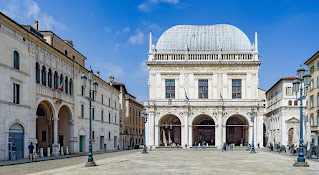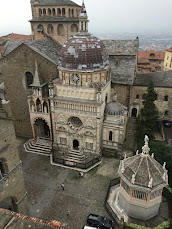Talented artist from Brescia acclaimed for sacred paintings and portraits
 |
| Alessandro Bonvicino was an acclaimed painter in Brescia |
Nicknamed Il Moretto da Brescia - the little moor from Brescia - Bonvicino is known to have painted alongside the Venetian artist Lorenzo Lotto in Bergamo. The portrait painter Giovanni Battista Moroni from Albino, in the province of Bergamo, was one of his pupils.
Bonvicino, sometimes known as Buonvicino, was born in Rovato, a town in the province of Brescia, in about 1498. It is not known how he acquired his nickname of Il Moretto.
He studied painting under Floriano Ferramola, but is also believed to have trained with Vincenzo Foppa, a painter who was active in Brescia in the early years of the 16th century.
It is thought he may also have been an apprentice to Titian in Venice and it is known that he modelled his portrait painting on the Venetian style. Bonvicino is believed to have admired Raphael, although there is no evidence he ever travelled to Rome. He specialized in painting altarpieces in oils rather than in fresco.
 |
| Il Moretto's Madonna and Child with an Angel, which is on display in Milan's Pinacoteca di Brera |
His paintings can be found in many other churches in Brescia, Bergamo, Milan and Verona and in the collections of the National Gallery in London, the Metropolitan Museum in New York and the Hermitage in St Petersburg, as well as galleries in Milan, Venice, Paris, Vienna, Frankfurt, Oxford, Washington and Budapest.
Bonvicino’s 1526 Portrait of a Man, which now hangs in the National Gallery, is said to be the earliest Italian full-length portrait. The setting for his subject, who is leaning on a classical column, was later to be emulated by Moroni.
Noted for his piety, Bonvicino prayed and fasted before embarking on any sacred work of art, such as painting the Virgin Mother. He spent most of his life in Brescia and belonged to two of the religious confraternities there. He died, aged about 56, in Brescia.
 |
| The Piazza della Loggia is an elegant square in the centre of the city of Brescia |
Brescia is a town of great artistic and architectural importance and is the second city in Lombardia, after Milan. It has Roman remains and well-preserved Renaissance buildings but is not as well-known to tourists as the other historic Italian cities. Brescia became a Roman colony before the birth of Christ and you can still see remains from the forum, theatre and a temple. The town was fought over by different rulers in the Middle Ages but came under the protection of Venice in the 15th century. There is a distinct Venetian influence in the architecture of the Piazza della Loggia, an elegant square in the centre of the town, which has a clock tower remarkably similar to the one in Saint Mark’s square in Venice. Next to the 17th century Duomo is an older cathedral, the unusually shaped Duomo Vecchio, also known as la Rotonda, where Bonvicino painted in the 16th century. The Santa Giulia Museo della Citta covers more than 3000 years of Brescia’s history, housed within the Benedictine Nunnery of San Salvatore and Santa Giulia in Via Musei. The nunnery was built over a Roman residential quarter, but some of the houses, with their original mosaics and frescoes, have now been excavated and can be seen while you are looking round the museum.
Travel tip:The Basilica with the Colleoni
Chapel in the foreground
It is known that Bonvicino painted alongside Lorenzo Lotto in the beautiful Basilica di Santa Maria Maggiore in Piazza Duomo in Bergamo’s Città Alta. The basilica, which dates back to the 12th century, is considered to be one of the finest buildings in Lombardy with a cupola that was richly decorated in the 16th century. At the back of the church is an elaborate white marble monument designed by Vincenzo Vela, marking the tomb of composer Gaetano Donizetti, who was born in Bergamo and returned to die in the city. Nearby there is a monument to his teacher Simon Mayr, who was maestro of the chapel in the basilica. There is an elaborately carved wooden confessional designed by Andrea Fantoni in 1704 and an altar rail with wood carvings following designs by Lorenzo Lotto.
Also on this day:
1821: The birth of musician Giovanni Bottesini
1858: The birth of opera composer Giacomo Puccini
1908: The birth of sculptor Giacomo Manzù
1963: The birth of footballer Giuseppe Bergomi

No comments:
Post a Comment